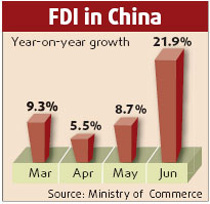By Ingo Beyer von Morgenstern and Paul Gao
Many multinational hi-tech firms in China are facing stagnation or even declining market share as Chinese competitors secure the emerging mid-range market for hi-tech goods.
McKinsey research shows that 30 to 75 percent of future growth in the global hi-tech industry will be in this mid-range segment, defined as products priced between 30 percent and 50 percent less than their premium counterparts.
Chinese hi-tech firms are quickly edging out global firms in capturing the emerging mid-range market. By defining innovation differently and looking for value throughout the business system, Chinese firms get more out of every R&D dollar spent, allowing them to launch goods cheaper and quicker than their global competitors.
Worryingly for global firms, enormous inefficiencies in their own R&D processes mean Chinese companies have a huge scope for productivity, cost and innovation gains. Many multinationals are aggressively hiring Chinese R&D managers and collaborating with global technical service partners to implement streamlined R&D processes.
Even more worryingly, as soon as Chinese manufacturers secure the global market for mid-range goods, they will gain the cost and scale advantages needed to move up the value chain into premium products. From there, it's just a matter of time before they capture high-end share from foreign firms in China and, eventually, in more developed markets.
For global manufacturers, achieving competitiveness in the mid-range segment will not be easy. Years of cumulative R&D experience have been directed at hi-tech innovation and superior quality, and as a result, products are often over-engineered for Chinese customers.
One European supplier of industrial components, for example, rigorously tests its highly engineered products to ensure a 5- to 10-year lifespan, but sells to Chinese manufacturers whose products only last three years.
Global tech players need to completely rethink their R&D approach and rediscover the lost art of low-cost R&D. They must ask what kind of products customers are demanding, and then redesign their R&D processes to meet these lower specifications and cost points.
Perhaps the only truly effective way they can do this is to bring their R&D capabilities to China, much as they have already done with manufacturing.
In doing so, global companies need to avoid the temptation to bring in too many expatriate engineers who implement traditional R&D processes that are unsuitable in China.
Chinese engineers already have the required technical know-how, so firms only need to bring in a few foreign experts to hone specific skills, such as the ability to translate consumer needs into technical specifications, instilling standardized R&D processes, maintaining end-to-end oversight, and designing a local production solution that best balances cost, quality and stability.
Rather than building their own localized R&D teams from scratch, firms could also acquire a local competitor and take over the company's R&D operations and processes. Its products could then be subsumed under the global brand, or retained as a sub-brand to avoid diluting the premium brand's image.
Some companies have already succeeded at localizing R&D to tap into the low-cost approaches of its Chinese counterparts. One global medical equipment maker, for instance, increased its market share from 18 to 45 percent by localizing its R&D processes to better meet the needs - and budgets - of potential customers in China.
Motorola and Nokia quickly identified what Chinese consumers wanted and could afford, and now develop mobile phones that span the entire price range. Together, they now capture over 50 percent of all mobile phone sales in China.
Other global manufacturers hoping to follow in their footsteps must go under a major mindset shift to make the necessary transition from "Made in China" to "Designed in China, for China".
Those companies who do not quickly take steps to produce the mid-range products currently in demand will be left behind in the world's most important emerging market. From there, it will be much harder to defend global market share against the rising tide of Chinese hi-tech goods.
Ingo Beyer von Morgenstern is a Shanghai-based director at McKinsey & Company. Paul Gao is a partner at McKinsey's Shanghai office
(China Daily August 15, 2007)


